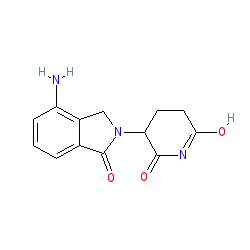|
Synonyms: CC-5013 | CDC-501 | Revlimid®
lenalidomide is an approved drug (FDA (2005), EMA (2007))
Compound class:
Synthetic organic
Comment: Lenalidomide is a derivative of thalidomide with anti-inflammatory and anti-cancer actions.
Ligand Activity Visualisation ChartsThese are box plot that provide a unique visualisation, summarising all the activity data for a ligand taken from ChEMBL and GtoPdb across multiple targets and species. Click on a plot to see the median, interquartile range, low and high data points. A value of zero indicates that no data are available. A separate chart is created for each target, and where possible the algorithm tries to merge ChEMBL and GtoPdb targets by matching them on name and UniProt accession, for each available species. However, please note that inconsistency in naming of targets may lead to data for the same target being reported across multiple charts. ✖ |
|
|||||||||||||||||||||||||||||||||||
| No information available. |
Summary of Clinical Use  |
| Used in combination with anti-inflammatory dexamethasone as a second line therapy to treat multiple myeloma and other myelodysplastic syndromes (in particular, it is a highly effective treatment for myelodysplastic syndrome with deletion of chromosome 5q [1-2]). Lenalidomide is considered an orphan drug as the diseases for which it is indicated are rare. In February 2015, the US FDA extended approval of the lenalidomide/dexamethasone combination to include use as a first line treatment for patients with newly diagnosed multiple myeloma. In February 2017, the FDA expanded approval for use as maintenance therapy for patients with multiple myeloma following autologous stem cell transplant. Use of lenalidomide in combination with rituximab (or a rituximab biosimilar agent) was FDA approved in May 2019 as therapy for previously treated follicular lymphoma and previously treated marginal zone lymphoma (MZL). |
Mechanism Of Action and Pharmacodynamic Effects  |
| The precise mechanism of action of this drug has not been fully resolved. Drug action appears to be multi-faceted, exhibiting direct anti-tumour action, anti-angiogenic action, as well as immunomodulatory activity. LIke thalidomide, lenalidomide has been shown to interact with the ubiquitin E3 ligase component, cereblon [5]. When lenalidomide binds to CRBN, the lymphoid transcription factors Ikaros (IKZF1) and Aiolos (IKZF3) are degraded, and in addition casein kinase 1α (CK1α; CSNK1A1) is degraded. Reducing levels of CK1α confers lenalidomide's particular efficacy in treating myelodysplastic syndrome with deletion of chromosome 5q [1-2]. |
External links  |
|
For extended ADME data see the following: Electronic Medicines Compendium (eMC) Drugs.com European Medicines Agency (EMA) |









